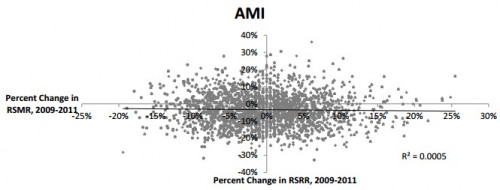From “Limits Of Readmission Rates In Measuring Hospital Quality Suggest The Need For Added Metrics,” by Matthew Press et al.:
Readmission rates in 2011 had a weak or inverse correlation with the other commonly used indicators of hospital quality (Appendix E). There were no significant differences in mean readmission rates across all quartiles of mortality rates for heart attack and pneumonia (19.8–19.9 percent and 18.4– 18.5 percent, respectively). For heart failure, mean readmission rates were significantly higher for the hospitals in the lowest mortality quartile (25.2 percent versus 24.9 percent, 24.8 percent, and 24.5 percent for the higher mortality quartiles). Results comparing the change in readmission and mortality rates longitudinally, which controls for time-invariant hospital confounders, showed a weak correlation between the two outcomes for all three conditions (Appendix F).
Here’s what one of those plots from the appendix looks like (RSMR = risk-standardized mortality rate, RSRR = risk-standardized readmission rate):
Hospitals in the quartile with the highest composite process-measure performance had average readmission rates of 19.8 percent, 25.0 percent, and 18.4 percent for the three conditions respectively, compared with 20.0 percent, 24.9 percent, and 18.5 percent for hospitals in the quartile with the lowest performance. [] Some of the differences in readmission rates were statistically significant. However, the directionality of the trend differed across the conditions, and the differences in readmission rates were clinically insignificant, which indicates that the correlations were weak.
The cross-sectional association between the Hospital Compare quality designations for readmission and mortality in 2011 was sometimes conflicting []. Of the hospitals designated “worse than the US national rate” for readmission for heart attack, heart failure, and pneumonia, 6 (18 percent), 41 (22 percent), and 12 (10 percent), respectively, were designated “better than the US national rate” for mortality. Of the hospitals designated “better than the US national rate” for readmission for heart attack, heart failure, and pneumonia, 0, 13 (11 percent), and 1 (2 percent), respectively, were designated as “worse than the US national rate” for mortality
Either readmission rates are not measuring quality or they are measuring a type of quality not captured by mortality and process measures.
UPDATE: Somewhat related, there is news out today that as readmission rates have fallen over the last few years, the number of patients placed on observation status has risen. Placement on observation isn’t counted as an admission.



